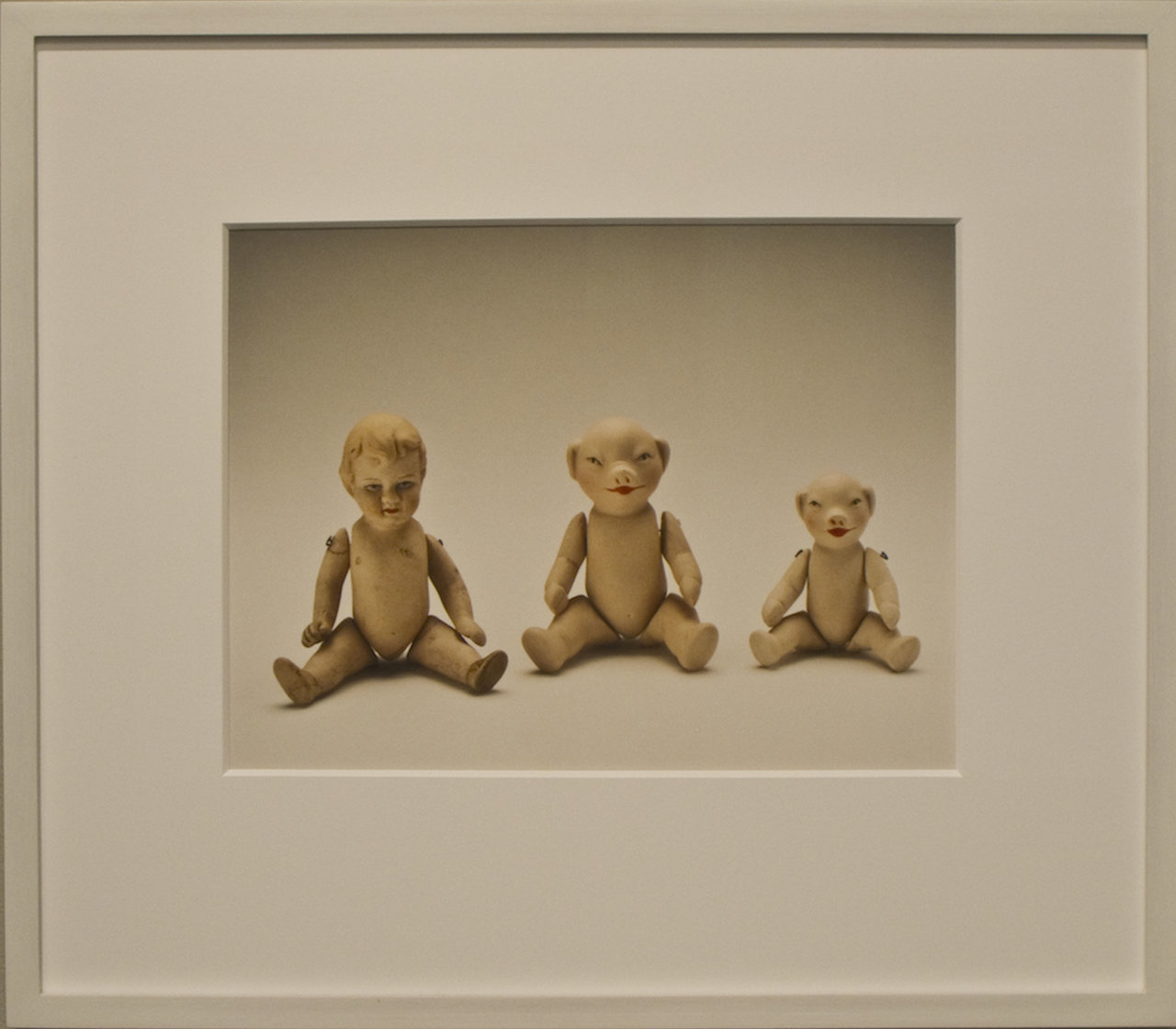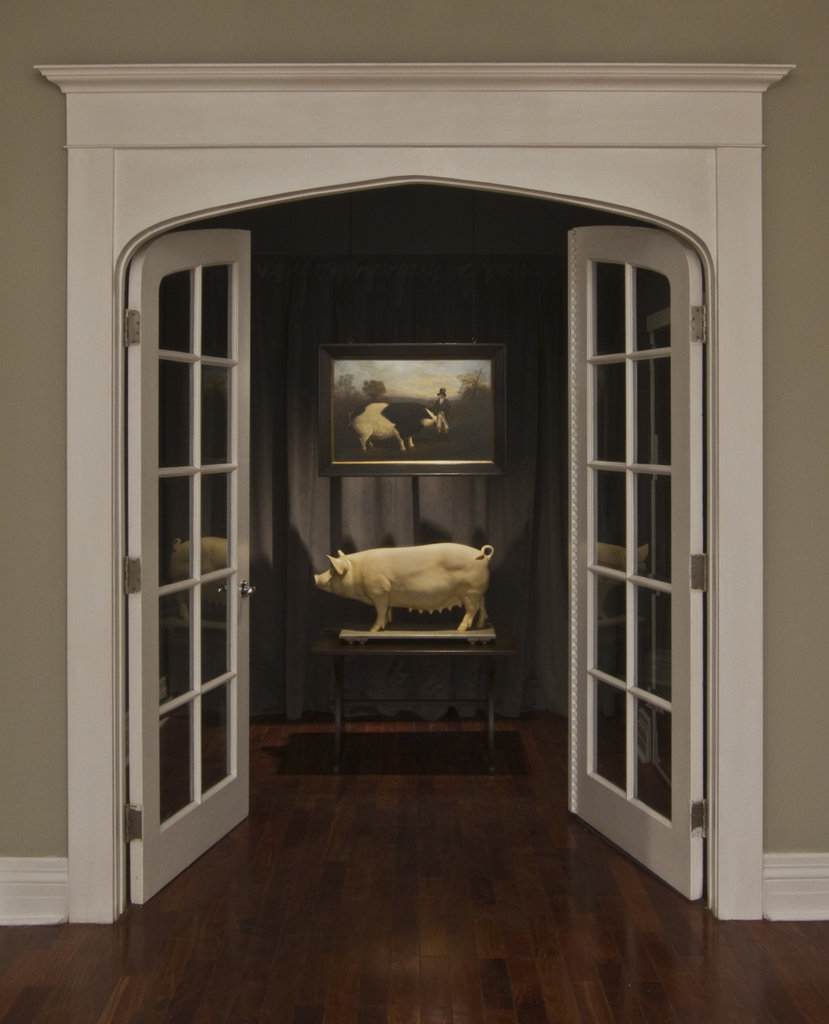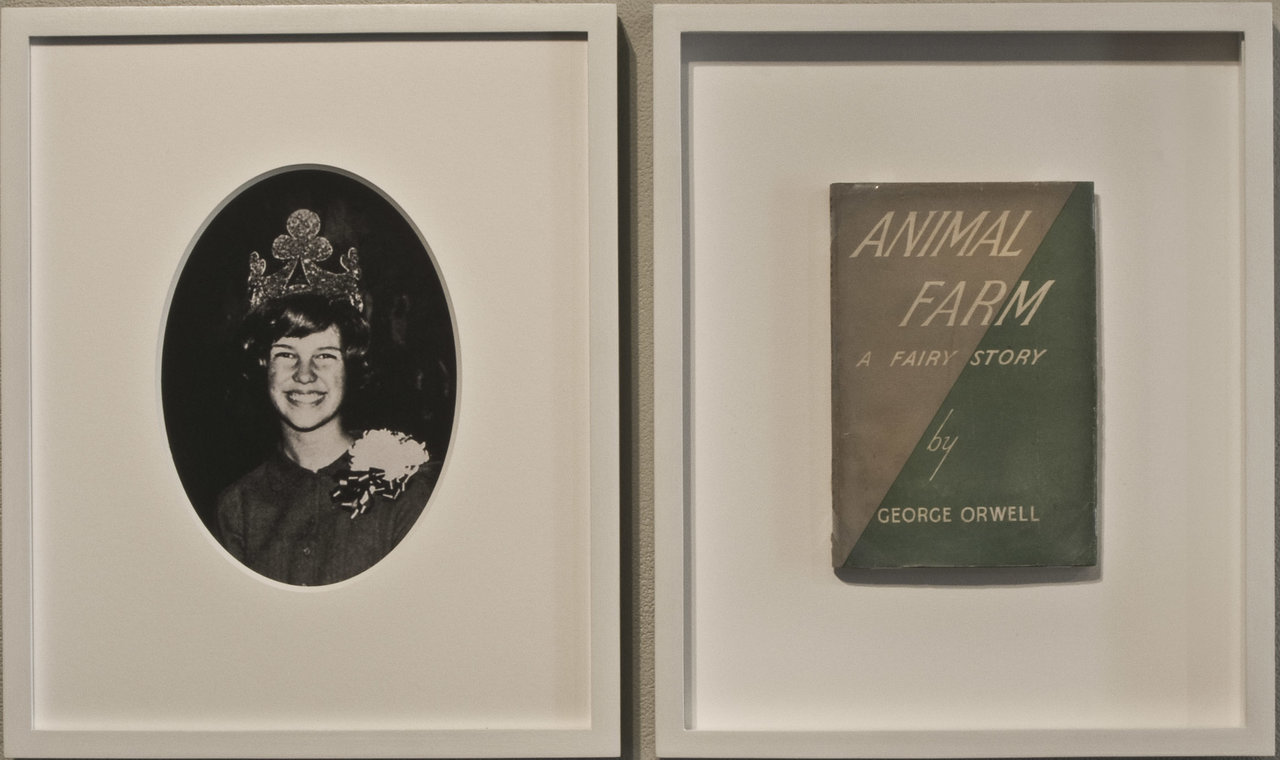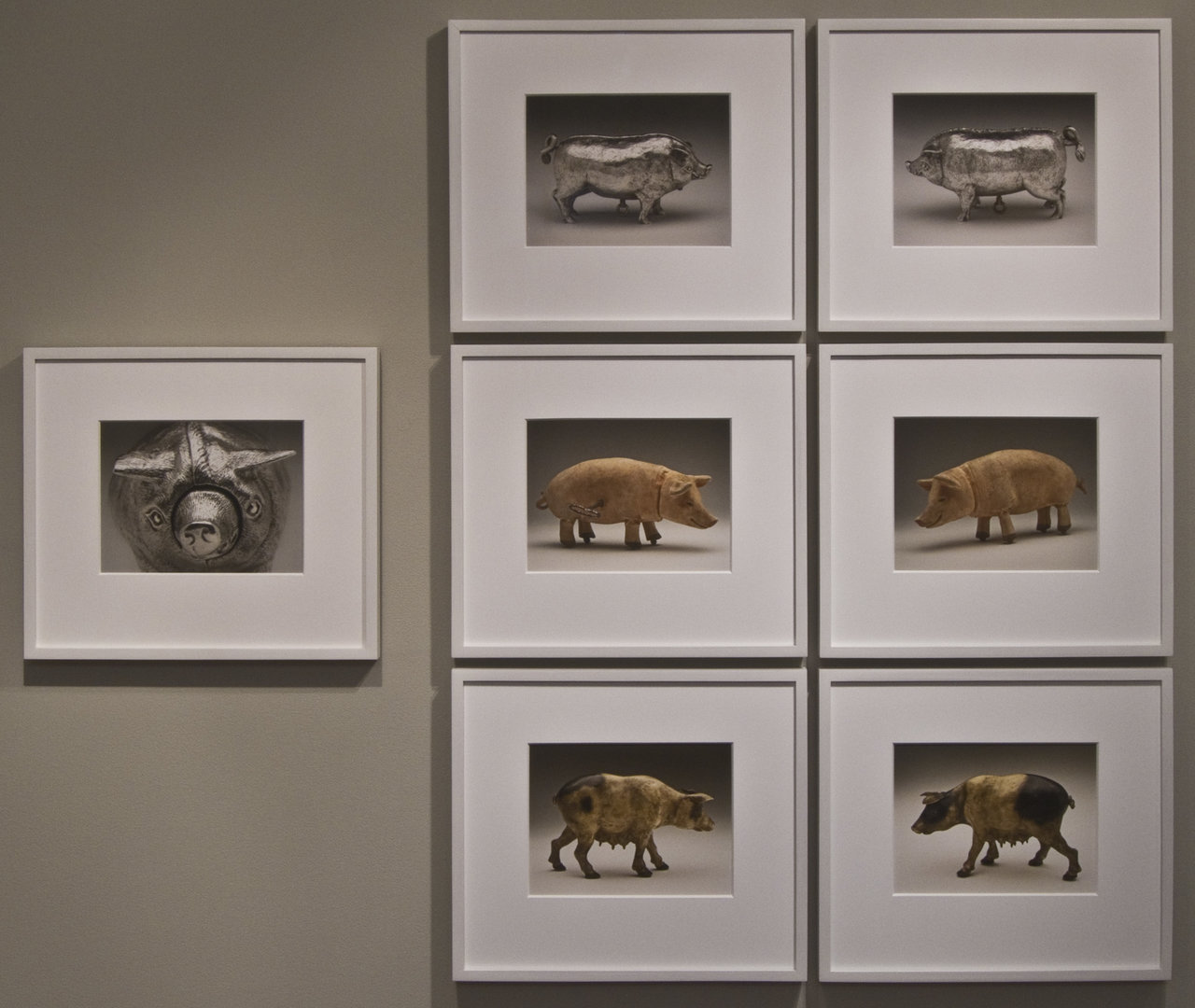It is believed that society is intrinsically progressive and prospective. From our experiences as “civilized” beings, society – or at least its idealistic perception – is guiltless and without fault. However, as Ydessa Hendeles strives to explain through her curated exhibition, there are often ironic undertones behind many existing practices. As she describes, her selected works addresses “our social and political capacity to put constructive, sometimes Utopian, forces to destructive ends.” This duality is embodied by Hendeles’ encompassing metaphor of pigs, their societal role, and their cultural allusions. Despite their relative intelligence and behaviour compared to other domesticated animals, they are often synonymous with vulgarity and filth. This mentality is why certain cultures, such as the Judaic and Islamic, avoid its consumption while others use this perspective to justify their maltreatment. Likewise, their image has been equated with the most negative human qualities, describing the bourgeoisie and the peasantry; the establishment and the revolutionaries; the exploited and the exploiters alike.
 Ydessa Hendeles, Family, 2015, pigment print on archival paper, framed in hand-painted white poplar frame of 16 3/4” x 19 1/8” x 1 1/2″. Photo: Robert Keziere. Courtesy of Barbara Edwards Contemporary
Ydessa Hendeles, Family, 2015, pigment print on archival paper, framed in hand-painted white poplar frame of 16 3/4” x 19 1/8” x 1 1/2″. Photo: Robert Keziere. Courtesy of Barbara Edwards Contemporary
The largest of the installations, Prize, consists of an anatomical model of a pig atop a child’s table and an English Naïve School oil painting suspended from steel chains. One of the school’s most popular subjects during the 19th century was the prize-winning livestock of fairs, estates, and markets and their owners. Compared to other animals such as cattle, sheep, and horses, pigs were rarely depicted because of their relative lack of appeal. By contrast, evolutionary and biological studies have shown pigs to demonstrate considerable intellect compared to cats and dogs in addition to close genetic ties they have to humans. The pairing of these works seem to allude to the contrasting scientific and socio-economic perceptions surrounding pigs.
 Ydessa Hendeles, Prize, 2015, oil painting suspended from painted steel chains, anatomical model, child’s table, installation dimensions: 116” x 36″ x 24″. Photo: Robert Keziere. Courtesy of Barbara Edward Contemporary
Ydessa Hendeles, Prize, 2015, oil painting suspended from painted steel chains, anatomical model, child’s table, installation dimensions: 116” x 36″ x 24″. Photo: Robert Keziere. Courtesy of Barbara Edward Contemporary
The title Death to Pigs is a reference to the Manson family murders in the summer of 1969, which were infamously inspired by the Beatles’ song Piggies. Emerging during the break of the Vietnam War and the surmounting paranoia of the Cold War, the song was intended to incite popular protest against the people who perpetuate the conflict (commonly recognized as the “establishment”). Therefore, Hendeles’ photograph entitled Princess, depicts a young Leslie Van Houten, who eagerly becomes a member of the family’s perverse ideal. Its original prospect of peacefulness and happiness became warped by the misinterpretation, or perhaps the over-interpretation, of this activist message, leading Van Houten to participate in the brutal murder of Leno and Rosemary LaBianca.
 Ydessa Hendeles, Princess (1964), 2015, pigment print on archival paper and first edition copy of Animal Farm (1945) by George Orwell, both framed in hand painted white poplar frames, installation dimensions: 14 1/2” x 24 9/16″ x 1 3/8″. Photo: Robert Keziere. Courtesy of Barbara Edwards Contemporary
Ydessa Hendeles, Princess (1964), 2015, pigment print on archival paper and first edition copy of Animal Farm (1945) by George Orwell, both framed in hand painted white poplar frames, installation dimensions: 14 1/2” x 24 9/16″ x 1 3/8″. Photo: Robert Keziere. Courtesy of Barbara Edwards Contemporary
Accompanying her photograph is a first edition copy (printed and bound in 1945 following the Second World War) of George Orwell’s Animal Farm: A Fairy Story, in which he masterfully recreates the progression of Russian history following the rise of the Communists. What began as an inspirational rebellion against the oppressive rule of the bourgeoisie eventually devolved into the highly-bureaucratized, ruthless Stalinist regime, despite claiming to have followed those original principles of equality and fairness. Following the course of history, in the book, Napoleon (the leading pig) assumes the role of the ideological pedagogue, transforming the idealistic egalitarianism into an autocratic hierarchy: according to Orwell, “everyone is equal, but some are more equal than others.”
 Ydessa Hendeles, Three Little Pigs, 2015, sound video housed in custom-made, wall-mounted 1/4 inch steel plate box with key-lock door and antique chain; cast-bronze sculpture on wall-mounted steel shelf, installation dimensions: 22 3/8” x 35” x 4 3/4″. Photo: Robert Keziere. Courtesy of Barbara Edwards Contemporary
Ydessa Hendeles, Three Little Pigs, 2015, sound video housed in custom-made, wall-mounted 1/4 inch steel plate box with key-lock door and antique chain; cast-bronze sculpture on wall-mounted steel shelf, installation dimensions: 22 3/8” x 35” x 4 3/4″. Photo: Robert Keziere. Courtesy of Barbara Edwards Contemporary
Death to Pigs is a multimedia collection of images and artifacts that explore some of the societal allegories and allusions associated with the imagery of pigs. It is intrinsically diverse and interdisciplinary, venturing through history and across cultures to deliver a rich yet still comprehensive view into the multiple iterations. In doing so, Hendeles not only offers a glimpse into the complex development of the “pig” in human civilization; she exposes much of the controversial, characteristically “vulgar” underbelly of the human condition, or rather the potential it has to descend to the begotten level.
 Ydessa Hendeles, Nose, 2015, seven pigment prints on archival paper, framed in hand-painted white poplar frames, installation dimensions: 46 5/8” x 55 5/8″ x 1 1/2″. Photo: Robert Keziere. Courtesy of Barbara Edwards Contemporary
Ydessa Hendeles, Nose, 2015, seven pigment prints on archival paper, framed in hand-painted white poplar frames, installation dimensions: 46 5/8” x 55 5/8″ x 1 1/2″. Photo: Robert Keziere. Courtesy of Barbara Edwards Contemporary
Simon Termine
*Exhibition information: October 7 – December 10, 2016, Barbara Edwards Contemporary, 1069 Bathurst Street, Toronto. Gallery hours: Tue to Sat, 11 am – 6 pm (or by appointment).
